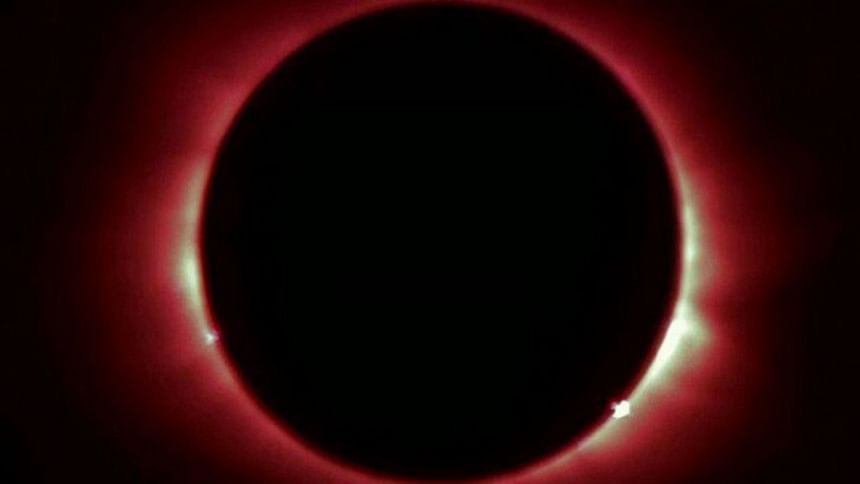'Breathtaking' solar eclipse occurs

Millions of people in the UK and northern Europe have glimpsed the best solar eclipse in years.
In a solar eclipse, a swathe of the Earth is plunged into darkness as the Moon comes between us and the Sun.
From an aeroplane above the Faroe Islands, a BBC camera captured startling footage of the event reaching totality at 09:41 GMT.
As the Sun emerges from behind the Moon, people are still advised not to look directly at the phenomenon.
This is because even during the eclipse, looking directly at the Sun causes serious harm - but there are ways to watch the eclipse safely and many people have taken the chance to do so.
In all parts of the UK the eclipse reached at least 83% and the darkness peaked at about 09:35 GMT.
Actual viewing opportunities were heavily dependent on the cloud cover that shrouded much of the country.
The deep shadow formed first in the North Atlantic, before sweeping up into the Arctic Circle and ending at the North Pole.
The UK will not see a solar eclipse on this scale again until 2026.
The exact moment of greatest darkness for UK skywatchers was dependent on their location.
Penzance, in Cornwall, for example, had this moment at 09:23 GMT, whereas for Lerwick in the Shetland Islands, it happened at 09:43 GMT.
For the Shetlands, the eclipse was very nearly total at 97%.
To experience totality required going further north still - such as the trip taken by a BBC camera operator above the clouds in the Faroes.
Few land areas fall directly in the path of the Moon's deepest shadow - its so-called umbra - and seabirds will probably have had the best eclipse experience.
The period of greatest darkness - nearly three minutes - occurred over a spot in the Norwegian Sea, a little below the Arctic Circle, at 09:46 GMT.
Many professional and amateur astronomers positioned themselves in the Faroe Islands, where the capital city of Torshavn got totality for a full two minutes, beginning just before 09:41 GMT.
And those who could not book a flight or a hotel for the Faroes went to Svalbard, where the capital city of Longyearbyen witnessed two-and-a-half minutes of totality, starting shortly after 10:10 GMT.
For those caught under cloudy skies, the internet was a good option to see the eclipse.
Scientific agencies had planes and even satellites gathering video to relay on the web and on television.
In the UK, the weather turned out to be slightly better than anticipated, with clouds breaking in many places at just the right time. London and the South East, on the other hand, just saw their grey day get slightly gloomier.
Irrespective of the cloud cover, scientists said citizens could still help them with their research.
A University of Reading team wants to learn more about how the atmosphere behaves as the Moon's shadow runs over the Earth.
The National Eclipse Weather Experiment (NEWEx) asked people to record conditions at their locality.
Prof Giles Harrison explained: "This is the first big partial eclipse to happen in the UK since 1999, and the next one isn't until August 2026, so this is a once-in-a-generation opportunity.
"By observing what happens on Friday we are effectively turning the skies of Britain into a giant weather lab, giving us a rare chance to see what happens when you 'turn down the Sun'.
"This will give us a precious insight into how the Sun influences the clouds and wind, as well as more obvious effects, such as temperature.
"By improving our understanding of how the weather works, we're better able to predict it, meaning scientists can further improve weather forecasts."
'ECLIPSE WIND'
One phenomenon the experiment hopes to investigate is the "eclipse wind". This refers to changes in the breeze that eclipse observers have reported as darkness falls.
Oxford University scientists, meanwhile, are using the event to try to understand how eclipses affect electricity grids.
The deep shadow will have reduced the output from solar panels, which now supply a significant proportion of power needs right across Europe.
The researchers will look to see how this dip in performance impacted the stability of grid networks.
Next year will have a total solar eclipse, too.
That will occur on March 9, and will cross Sumatra, Borneo, Sulawesi, and extend out over the Pacific.

 For all latest news, follow The Daily Star's Google News channel.
For all latest news, follow The Daily Star's Google News channel. 



Comments